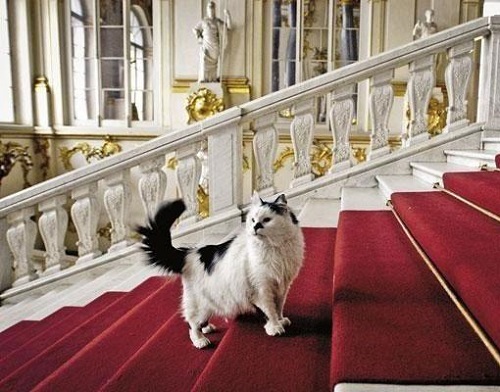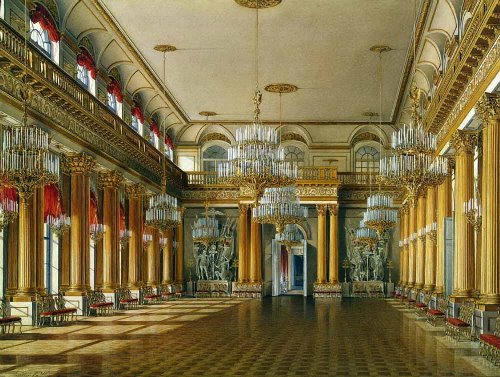Walking in the Hermitage – part 1
Walking in the Hermitage – part 1.
Five buildings connected to each other at the Palace Embankment, the Hermitage Museum, are:
* The Winter Palace (1754 – 1762, architect B. Rastrelli)
* Small Hermitage (1764 – 1775, architects JB Vallin de la Mothe, J. Velten, VP Stasov). The complex consists of the Small Hermitage North and South halls, and the famous Hanging Garden
* Large Hermitage (1771 – 1787, architect YM Felten)
* New Hermitage (1842 – 1851, architect Leo von Klenze, VP Stasov, N. Efimov)
* Hermitage Theater (1783 – 1787, architect G. Quarenghi)
View from the Neva to the complex of buildings of the State Hermitage Museum: Hermitage Theater left – Large (Old) Hermitage – Small Hermitage – Winter Palace, (New Hermitage is located behind the Great)
Hall of Majolica
The motives of New Hermitage Museum – Renaissance art. Here are two masterpieces of the Hermitage – “Madonna Conestabile” (1504) by Raphael and “The Holy Family” (1505-1506). The exhibition includes works by Italian masters of XV-XVI centuries, including students of Raphael – sculptural group “Dead Boy on a Dolphin” attributed to L. Lorenzetti, cardboard trellis “Procession of the bulls and elephants” created by J. Romano. In the hall there’s majolica, trellis “Apollo and the signs of the zodiac”, and decorative furniture.
The Conestabile Madonna is a small, probably unfinished painting by the Italian Renaissance artist Raphael. It was the last work painted by Raphael in Umbria before moving to Florence. It was acquired by Alexander II of Russia in 1871. The Tsar presented it to his consort, Maria Alexandrovna. Since then, the painting has been on exhibit in the Hermitage Museum of St. Petersburg.
One of the most beautiful interiors of the New Hermitage – Gallery of the History of Ancient Painting was opened after restoration on December 7, 2005. Interior Gallery, conceived by the architect Leo von Klenze as a prelude to the gallery of the Imperial Museum, recalls the traditions of ancient art, history and products, known only by the description of the ancient authors. Mounted in the wall paintings of scenes taken from the literature and myths, made by the German artist G. Hiltensperger in imitation of the ancient technique of encaustic – encaustic on brass boards.
Antonio Canova (1 November 1757 – 13 October 1822), Italian sculptor from the Republic of Venice who became famous for his marble sculptures that delicately rendered nude flesh
Collection of antiquities in the Hermitage has over 106.000 monuments of culture and art of ancient Greece, ancient Italy and Rome, ancient colonies of the North Black Sea coast. The earliest of them date back to the III century BC, the latest date from the IV. BC
This large exhibition hall was designed by the chief architect of the State Hermitage A.V. Sivkov in the place of the main buffet room of the Winter Palace in 1940, is now in the hall of an exhibition dedicated to the art and culture of ancient Egypt.
Two rows of monolithic columns of Serdobol granite divide it into three parts. Capitals of the columns, floors and walls are covered with paintings, motifs which date back to the decor of antique vases. The floor is made of stone mosaics at the Peterhof Lapidary Works, in imitation of the ancient tradition.
Twenty column Hall of the New Hermitage was designed by Leo von Klenze for an exhibition of Etruscan vases presented in the cabinet of birch wood inlaid with amaranth. In the hall there is a collection of Ancient Italy of late IX – II century. BC
Walking in the Hermitage

The Conestabile Madonna is a small (and probably unfinished) painting by the Italian Renaissance artist Raphael. It was the last work painted by Raphael in Umbria before moving to Florence. It was acquired by Alexander II of Russia in 1871. The Tsar presented it to his consort, Maria Alexandrovna. Since then, the painting has been on exhibit in the Hermitage Museum of St. Petersburg.

A Dead Boy on a Dolphin by Raphael’s disciple Lorenzo Lorenzetti (1490-1541) at the Majolica Room in the Hermitage

The Madonna with Beardless St. Joseph is an early painting by Raphael, produced in 1506, now at the Hermitage Museum
www.hermitagemuseum.org
liveinternet.ru/users/matrioshka


























































